International Marketing: A Comprehensive Analysis of Coca-Cola's Global Strategy
VerifiedAdded on 2024/05/23
|22
|5369
|169
AI Summary
This paper delves into the intricacies of international marketing, using Coca-Cola as a case study to illustrate key concepts and strategies. It examines the rationale behind Coca-Cola's global expansion, evaluates various market entry strategies, and analyzes the global versus local debate in marketing. The paper also explores the adaptation of the marketing mix across different international contexts, highlighting Coca-Cola's approach to product, price, promotion, and distribution. Finally, it provides recommendations on how organizations can structure themselves to maximize opportunities in an international context.
Contribute Materials
Your contribution can guide someone’s learning journey. Share your
documents today.

International Marketing
1
1
Secure Best Marks with AI Grader
Need help grading? Try our AI Grader for instant feedback on your assignments.
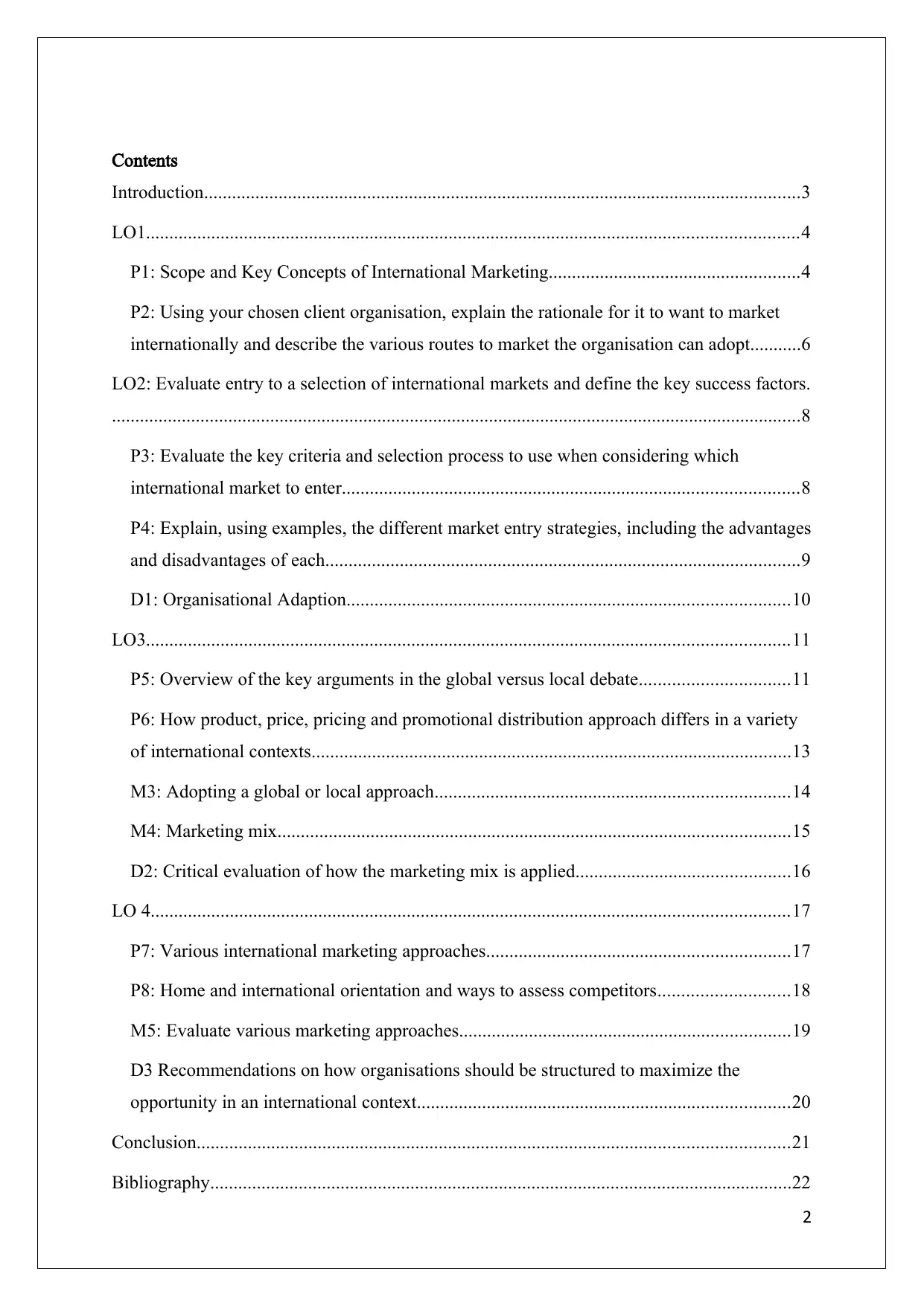
Contents
Introduction................................................................................................................................3
LO1............................................................................................................................................4
P1: Scope and Key Concepts of International Marketing......................................................4
P2: Using your chosen client organisation, explain the rationale for it to want to market
internationally and describe the various routes to market the organisation can adopt...........6
LO2: Evaluate entry to a selection of international markets and define the key success factors.
....................................................................................................................................................8
P3: Evaluate the key criteria and selection process to use when considering which
international market to enter..................................................................................................8
P4: Explain, using examples, the different market entry strategies, including the advantages
and disadvantages of each......................................................................................................9
D1: Organisational Adaption...............................................................................................10
LO3..........................................................................................................................................11
P5: Overview of the key arguments in the global versus local debate................................11
P6: How product, price, pricing and promotional distribution approach differs in a variety
of international contexts.......................................................................................................13
M3: Adopting a global or local approach............................................................................14
M4: Marketing mix..............................................................................................................15
D2: Critical evaluation of how the marketing mix is applied..............................................16
LO 4.........................................................................................................................................17
P7: Various international marketing approaches.................................................................17
P8: Home and international orientation and ways to assess competitors............................18
M5: Evaluate various marketing approaches.......................................................................19
D3 Recommendations on how organisations should be structured to maximize the
opportunity in an international context................................................................................20
Conclusion...............................................................................................................................21
Bibliography.............................................................................................................................22
2
Introduction................................................................................................................................3
LO1............................................................................................................................................4
P1: Scope and Key Concepts of International Marketing......................................................4
P2: Using your chosen client organisation, explain the rationale for it to want to market
internationally and describe the various routes to market the organisation can adopt...........6
LO2: Evaluate entry to a selection of international markets and define the key success factors.
....................................................................................................................................................8
P3: Evaluate the key criteria and selection process to use when considering which
international market to enter..................................................................................................8
P4: Explain, using examples, the different market entry strategies, including the advantages
and disadvantages of each......................................................................................................9
D1: Organisational Adaption...............................................................................................10
LO3..........................................................................................................................................11
P5: Overview of the key arguments in the global versus local debate................................11
P6: How product, price, pricing and promotional distribution approach differs in a variety
of international contexts.......................................................................................................13
M3: Adopting a global or local approach............................................................................14
M4: Marketing mix..............................................................................................................15
D2: Critical evaluation of how the marketing mix is applied..............................................16
LO 4.........................................................................................................................................17
P7: Various international marketing approaches.................................................................17
P8: Home and international orientation and ways to assess competitors............................18
M5: Evaluate various marketing approaches.......................................................................19
D3 Recommendations on how organisations should be structured to maximize the
opportunity in an international context................................................................................20
Conclusion...............................................................................................................................21
Bibliography.............................................................................................................................22
2

Introduction
International Marketing involves an organisation making marketing mix decisions in more
than one country. It involves establishment of manufacturing facilities overseas and
coordinating marketing strategies worldwide. Due to globalisation, present marketing
strategies aren’t restricted to remain confined within a country and instead, the world is an
open market. An association might need to market globally because of a potential
development and an expansion in sales, a little home market and more open doors abroad, to
dishearten nearby contenders, and exploit innovation and talented work force. The paper
looks at various techniques of marketing internationally as well as ways of improving global
market.
3
International Marketing involves an organisation making marketing mix decisions in more
than one country. It involves establishment of manufacturing facilities overseas and
coordinating marketing strategies worldwide. Due to globalisation, present marketing
strategies aren’t restricted to remain confined within a country and instead, the world is an
open market. An association might need to market globally because of a potential
development and an expansion in sales, a little home market and more open doors abroad, to
dishearten nearby contenders, and exploit innovation and talented work force. The paper
looks at various techniques of marketing internationally as well as ways of improving global
market.
3
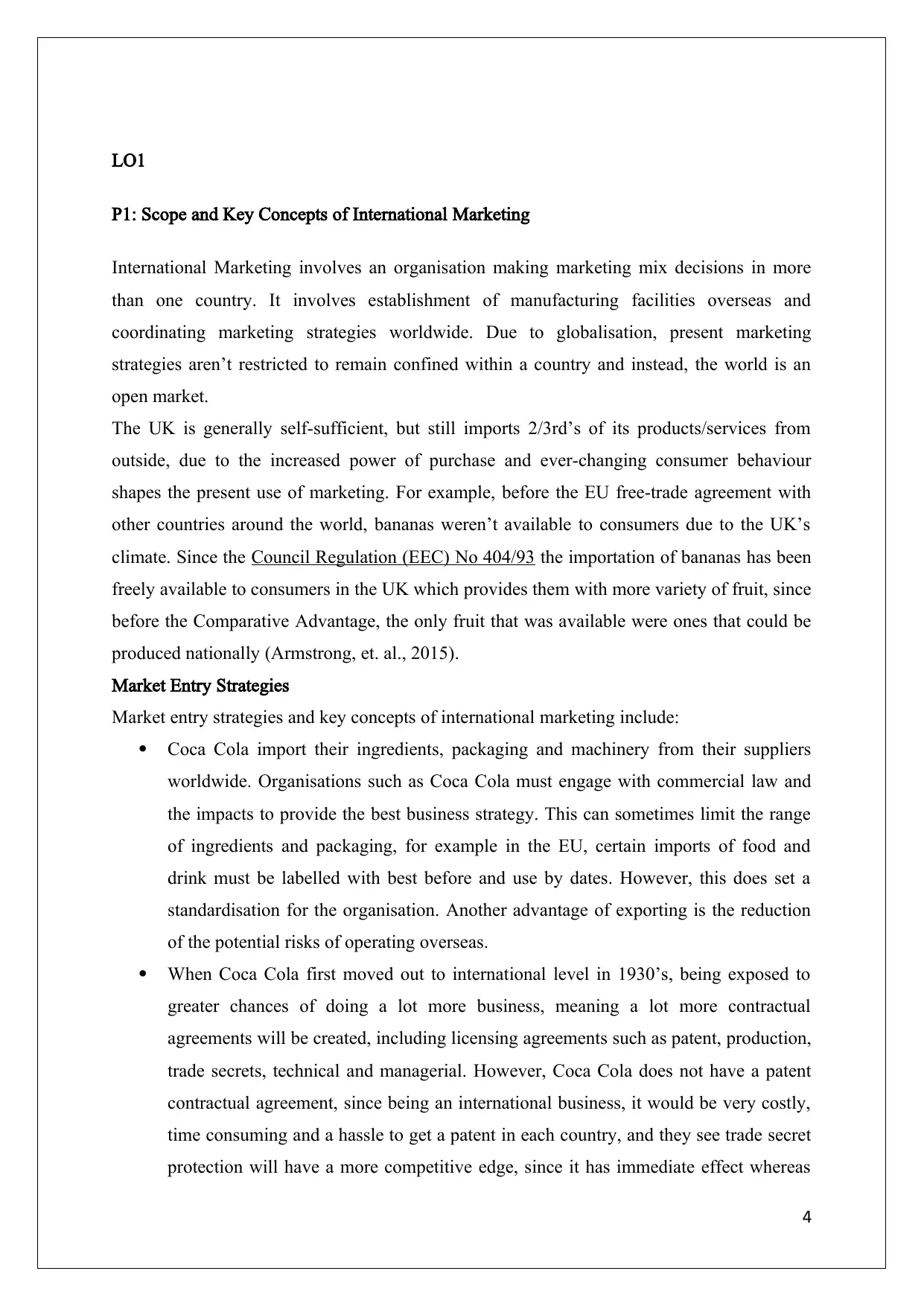
LO1
P1: Scope and Key Concepts of International Marketing
International Marketing involves an organisation making marketing mix decisions in more
than one country. It involves establishment of manufacturing facilities overseas and
coordinating marketing strategies worldwide. Due to globalisation, present marketing
strategies aren’t restricted to remain confined within a country and instead, the world is an
open market.
The UK is generally self-sufficient, but still imports 2/3rd’s of its products/services from
outside, due to the increased power of purchase and ever-changing consumer behaviour
shapes the present use of marketing. For example, before the EU free-trade agreement with
other countries around the world, bananas weren’t available to consumers due to the UK’s
climate. Since the Council Regulation (EEC) No 404/93 the importation of bananas has been
freely available to consumers in the UK which provides them with more variety of fruit, since
before the Comparative Advantage, the only fruit that was available were ones that could be
produced nationally (Armstrong, et. al., 2015).
Market Entry Strategies
Market entry strategies and key concepts of international marketing include:
Coca Cola import their ingredients, packaging and machinery from their suppliers
worldwide. Organisations such as Coca Cola must engage with commercial law and
the impacts to provide the best business strategy. This can sometimes limit the range
of ingredients and packaging, for example in the EU, certain imports of food and
drink must be labelled with best before and use by dates. However, this does set a
standardisation for the organisation. Another advantage of exporting is the reduction
of the potential risks of operating overseas.
When Coca Cola first moved out to international level in 1930’s, being exposed to
greater chances of doing a lot more business, meaning a lot more contractual
agreements will be created, including licensing agreements such as patent, production,
trade secrets, technical and managerial. However, Coca Cola does not have a patent
contractual agreement, since being an international business, it would be very costly,
time consuming and a hassle to get a patent in each country, and they see trade secret
protection will have a more competitive edge, since it has immediate effect whereas
4
P1: Scope and Key Concepts of International Marketing
International Marketing involves an organisation making marketing mix decisions in more
than one country. It involves establishment of manufacturing facilities overseas and
coordinating marketing strategies worldwide. Due to globalisation, present marketing
strategies aren’t restricted to remain confined within a country and instead, the world is an
open market.
The UK is generally self-sufficient, but still imports 2/3rd’s of its products/services from
outside, due to the increased power of purchase and ever-changing consumer behaviour
shapes the present use of marketing. For example, before the EU free-trade agreement with
other countries around the world, bananas weren’t available to consumers due to the UK’s
climate. Since the Council Regulation (EEC) No 404/93 the importation of bananas has been
freely available to consumers in the UK which provides them with more variety of fruit, since
before the Comparative Advantage, the only fruit that was available were ones that could be
produced nationally (Armstrong, et. al., 2015).
Market Entry Strategies
Market entry strategies and key concepts of international marketing include:
Coca Cola import their ingredients, packaging and machinery from their suppliers
worldwide. Organisations such as Coca Cola must engage with commercial law and
the impacts to provide the best business strategy. This can sometimes limit the range
of ingredients and packaging, for example in the EU, certain imports of food and
drink must be labelled with best before and use by dates. However, this does set a
standardisation for the organisation. Another advantage of exporting is the reduction
of the potential risks of operating overseas.
When Coca Cola first moved out to international level in 1930’s, being exposed to
greater chances of doing a lot more business, meaning a lot more contractual
agreements will be created, including licensing agreements such as patent, production,
trade secrets, technical and managerial. However, Coca Cola does not have a patent
contractual agreement, since being an international business, it would be very costly,
time consuming and a hassle to get a patent in each country, and they see trade secret
protection will have a more competitive edge, since it has immediate effect whereas
4
Secure Best Marks with AI Grader
Need help grading? Try our AI Grader for instant feedback on your assignments.
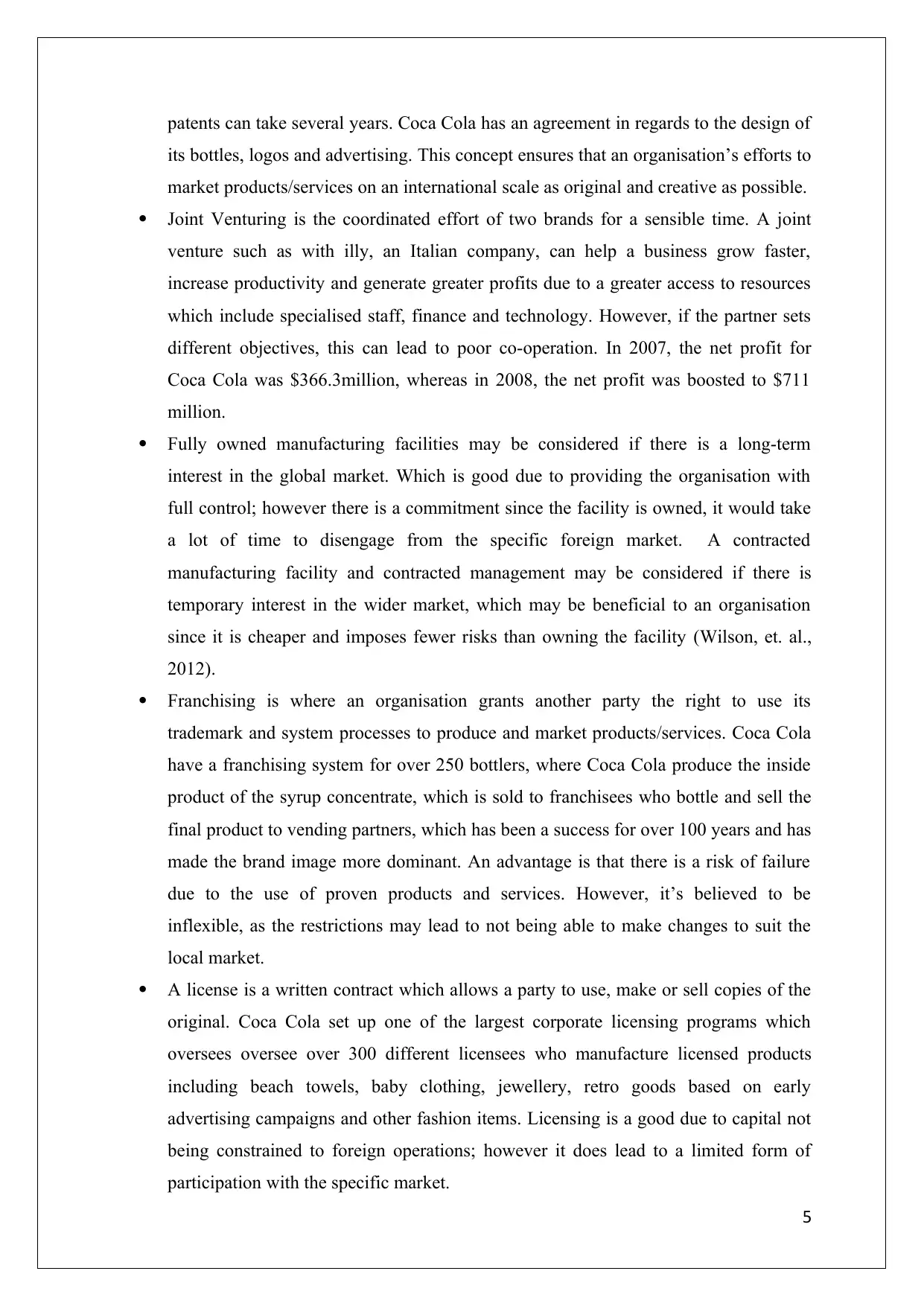
patents can take several years. Coca Cola has an agreement in regards to the design of
its bottles, logos and advertising. This concept ensures that an organisation’s efforts to
market products/services on an international scale as original and creative as possible.
Joint Venturing is the coordinated effort of two brands for a sensible time. A joint
venture such as with illy, an Italian company, can help a business grow faster,
increase productivity and generate greater profits due to a greater access to resources
which include specialised staff, finance and technology. However, if the partner sets
different objectives, this can lead to poor co-operation. In 2007, the net profit for
Coca Cola was $366.3million, whereas in 2008, the net profit was boosted to $711
million.
Fully owned manufacturing facilities may be considered if there is a long-term
interest in the global market. Which is good due to providing the organisation with
full control; however there is a commitment since the facility is owned, it would take
a lot of time to disengage from the specific foreign market. A contracted
manufacturing facility and contracted management may be considered if there is
temporary interest in the wider market, which may be beneficial to an organisation
since it is cheaper and imposes fewer risks than owning the facility (Wilson, et. al.,
2012).
Franchising is where an organisation grants another party the right to use its
trademark and system processes to produce and market products/services. Coca Cola
have a franchising system for over 250 bottlers, where Coca Cola produce the inside
product of the syrup concentrate, which is sold to franchisees who bottle and sell the
final product to vending partners, which has been a success for over 100 years and has
made the brand image more dominant. An advantage is that there is a risk of failure
due to the use of proven products and services. However, it’s believed to be
inflexible, as the restrictions may lead to not being able to make changes to suit the
local market.
A license is a written contract which allows a party to use, make or sell copies of the
original. Coca Cola set up one of the largest corporate licensing programs which
oversees oversee over 300 different licensees who manufacture licensed products
including beach towels, baby clothing, jewellery, retro goods based on early
advertising campaigns and other fashion items. Licensing is a good due to capital not
being constrained to foreign operations; however it does lead to a limited form of
participation with the specific market.
5
its bottles, logos and advertising. This concept ensures that an organisation’s efforts to
market products/services on an international scale as original and creative as possible.
Joint Venturing is the coordinated effort of two brands for a sensible time. A joint
venture such as with illy, an Italian company, can help a business grow faster,
increase productivity and generate greater profits due to a greater access to resources
which include specialised staff, finance and technology. However, if the partner sets
different objectives, this can lead to poor co-operation. In 2007, the net profit for
Coca Cola was $366.3million, whereas in 2008, the net profit was boosted to $711
million.
Fully owned manufacturing facilities may be considered if there is a long-term
interest in the global market. Which is good due to providing the organisation with
full control; however there is a commitment since the facility is owned, it would take
a lot of time to disengage from the specific foreign market. A contracted
manufacturing facility and contracted management may be considered if there is
temporary interest in the wider market, which may be beneficial to an organisation
since it is cheaper and imposes fewer risks than owning the facility (Wilson, et. al.,
2012).
Franchising is where an organisation grants another party the right to use its
trademark and system processes to produce and market products/services. Coca Cola
have a franchising system for over 250 bottlers, where Coca Cola produce the inside
product of the syrup concentrate, which is sold to franchisees who bottle and sell the
final product to vending partners, which has been a success for over 100 years and has
made the brand image more dominant. An advantage is that there is a risk of failure
due to the use of proven products and services. However, it’s believed to be
inflexible, as the restrictions may lead to not being able to make changes to suit the
local market.
A license is a written contract which allows a party to use, make or sell copies of the
original. Coca Cola set up one of the largest corporate licensing programs which
oversees oversee over 300 different licensees who manufacture licensed products
including beach towels, baby clothing, jewellery, retro goods based on early
advertising campaigns and other fashion items. Licensing is a good due to capital not
being constrained to foreign operations; however it does lead to a limited form of
participation with the specific market.
5
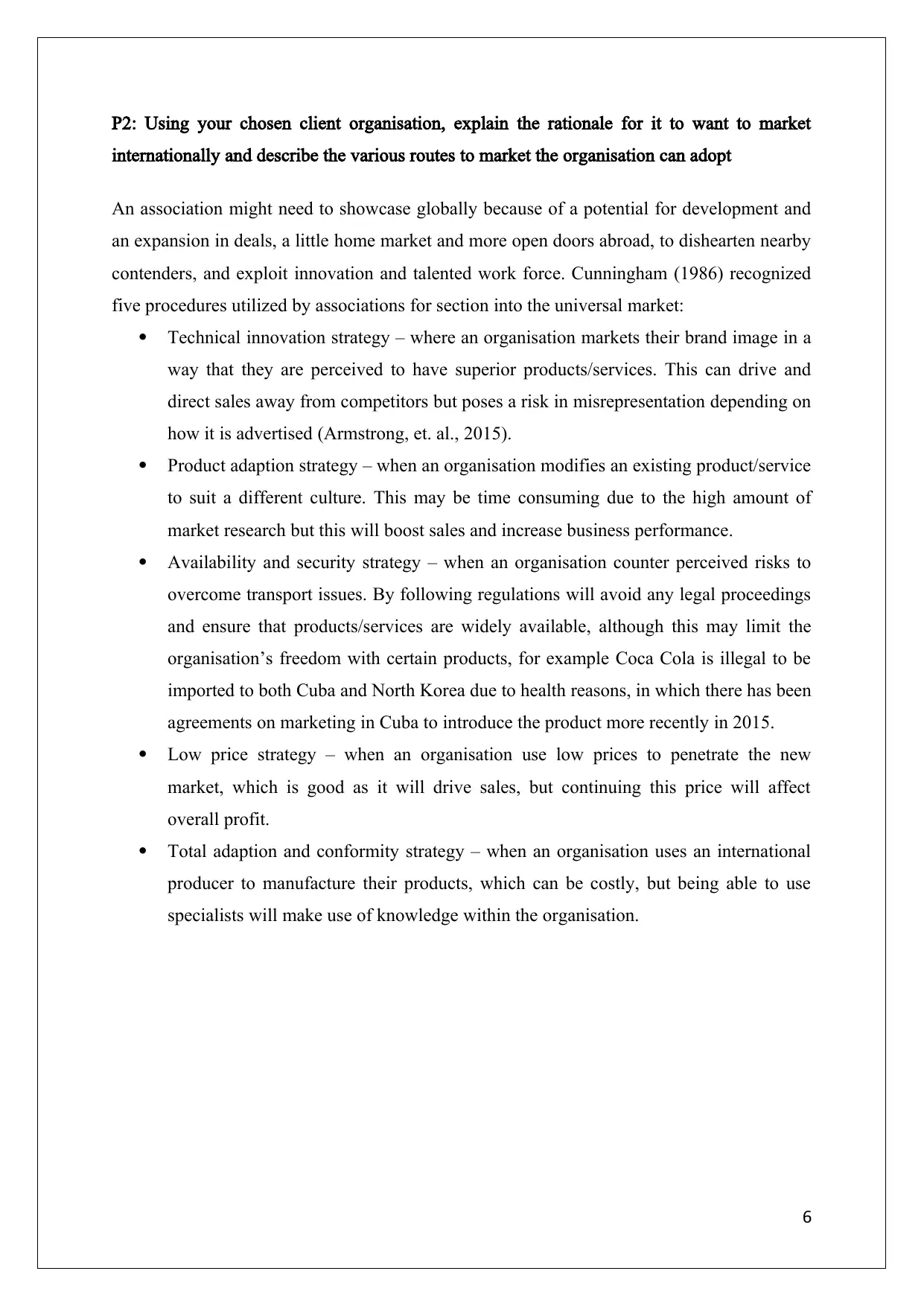
P2: Using your chosen client organisation, explain the rationale for it to want to market
internationally and describe the various routes to market the organisation can adopt
An association might need to showcase globally because of a potential for development and
an expansion in deals, a little home market and more open doors abroad, to dishearten nearby
contenders, and exploit innovation and talented work force. Cunningham (1986) recognized
five procedures utilized by associations for section into the universal market:
Technical innovation strategy – where an organisation markets their brand image in a
way that they are perceived to have superior products/services. This can drive and
direct sales away from competitors but poses a risk in misrepresentation depending on
how it is advertised (Armstrong, et. al., 2015).
Product adaption strategy – when an organisation modifies an existing product/service
to suit a different culture. This may be time consuming due to the high amount of
market research but this will boost sales and increase business performance.
Availability and security strategy – when an organisation counter perceived risks to
overcome transport issues. By following regulations will avoid any legal proceedings
and ensure that products/services are widely available, although this may limit the
organisation’s freedom with certain products, for example Coca Cola is illegal to be
imported to both Cuba and North Korea due to health reasons, in which there has been
agreements on marketing in Cuba to introduce the product more recently in 2015.
Low price strategy – when an organisation use low prices to penetrate the new
market, which is good as it will drive sales, but continuing this price will affect
overall profit.
Total adaption and conformity strategy – when an organisation uses an international
producer to manufacture their products, which can be costly, but being able to use
specialists will make use of knowledge within the organisation.
6
internationally and describe the various routes to market the organisation can adopt
An association might need to showcase globally because of a potential for development and
an expansion in deals, a little home market and more open doors abroad, to dishearten nearby
contenders, and exploit innovation and talented work force. Cunningham (1986) recognized
five procedures utilized by associations for section into the universal market:
Technical innovation strategy – where an organisation markets their brand image in a
way that they are perceived to have superior products/services. This can drive and
direct sales away from competitors but poses a risk in misrepresentation depending on
how it is advertised (Armstrong, et. al., 2015).
Product adaption strategy – when an organisation modifies an existing product/service
to suit a different culture. This may be time consuming due to the high amount of
market research but this will boost sales and increase business performance.
Availability and security strategy – when an organisation counter perceived risks to
overcome transport issues. By following regulations will avoid any legal proceedings
and ensure that products/services are widely available, although this may limit the
organisation’s freedom with certain products, for example Coca Cola is illegal to be
imported to both Cuba and North Korea due to health reasons, in which there has been
agreements on marketing in Cuba to introduce the product more recently in 2015.
Low price strategy – when an organisation use low prices to penetrate the new
market, which is good as it will drive sales, but continuing this price will affect
overall profit.
Total adaption and conformity strategy – when an organisation uses an international
producer to manufacture their products, which can be costly, but being able to use
specialists will make use of knowledge within the organisation.
6

M1: Opportunities and Challenges of International Marketing
The challenges that organisation’s face when marketing internationally are the internal
coordination of marketing. For a brand to be bigger they must campaign across multiple
territories such as foreign countries, which will cost more money and risk the potential
success of the organisation if profit isn’t made, however, the opportunity of a higher brand
awareness may lead to an increase in sales. Further challenges include reaching customers
appropriately. Depending on the chosen market sector, it may be more suitable to take
advantage of the opportunities that lie with technology such as social media which is far more
efficient, rather than make use of outdated methods to represent the organisation such as
radio, which is exclusively audio advertisement, limiting the organisation’s creativity.
Another opportunity is the understanding of consumer’s wants and needs (Babin and
Zigmond, 2015). Global market research will align the targeting messages of the
organisation, but a challenge is that it will require a deep understanding of the strength of a
country’s economy, industries, translation and demographics which will affect the marketing,
which can be time consuming and require skilful employees.
7
The challenges that organisation’s face when marketing internationally are the internal
coordination of marketing. For a brand to be bigger they must campaign across multiple
territories such as foreign countries, which will cost more money and risk the potential
success of the organisation if profit isn’t made, however, the opportunity of a higher brand
awareness may lead to an increase in sales. Further challenges include reaching customers
appropriately. Depending on the chosen market sector, it may be more suitable to take
advantage of the opportunities that lie with technology such as social media which is far more
efficient, rather than make use of outdated methods to represent the organisation such as
radio, which is exclusively audio advertisement, limiting the organisation’s creativity.
Another opportunity is the understanding of consumer’s wants and needs (Babin and
Zigmond, 2015). Global market research will align the targeting messages of the
organisation, but a challenge is that it will require a deep understanding of the strength of a
country’s economy, industries, translation and demographics which will affect the marketing,
which can be time consuming and require skilful employees.
7
Paraphrase This Document
Need a fresh take? Get an instant paraphrase of this document with our AI Paraphraser
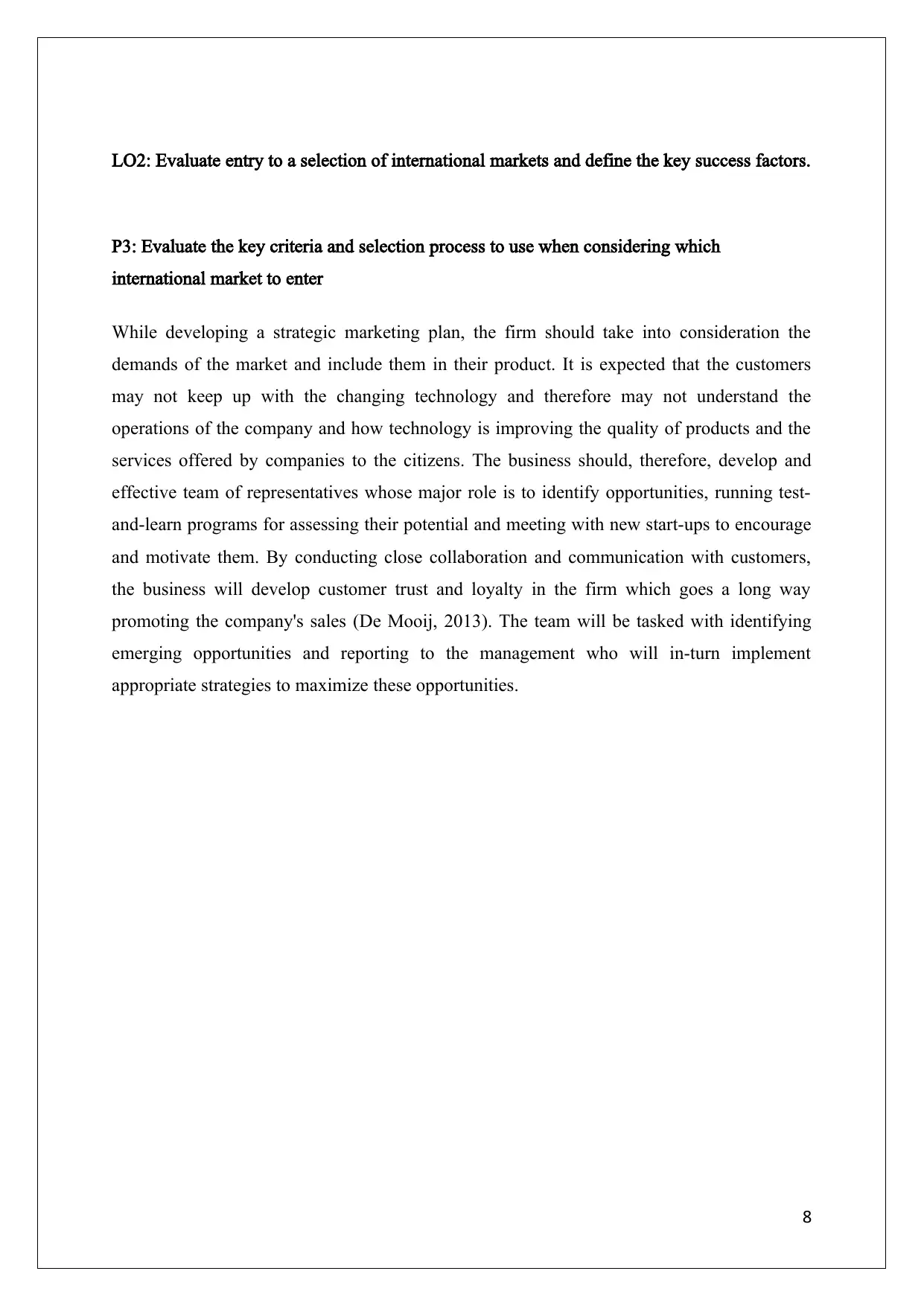
LO2: Evaluate entry to a selection of international markets and define the key success factors.
P3: Evaluate the key criteria and selection process to use when considering which
international market to enter
While developing a strategic marketing plan, the firm should take into consideration the
demands of the market and include them in their product. It is expected that the customers
may not keep up with the changing technology and therefore may not understand the
operations of the company and how technology is improving the quality of products and the
services offered by companies to the citizens. The business should, therefore, develop and
effective team of representatives whose major role is to identify opportunities, running test-
and-learn programs for assessing their potential and meeting with new start-ups to encourage
and motivate them. By conducting close collaboration and communication with customers,
the business will develop customer trust and loyalty in the firm which goes a long way
promoting the company's sales (De Mooij, 2013). The team will be tasked with identifying
emerging opportunities and reporting to the management who will in-turn implement
appropriate strategies to maximize these opportunities.
8
P3: Evaluate the key criteria and selection process to use when considering which
international market to enter
While developing a strategic marketing plan, the firm should take into consideration the
demands of the market and include them in their product. It is expected that the customers
may not keep up with the changing technology and therefore may not understand the
operations of the company and how technology is improving the quality of products and the
services offered by companies to the citizens. The business should, therefore, develop and
effective team of representatives whose major role is to identify opportunities, running test-
and-learn programs for assessing their potential and meeting with new start-ups to encourage
and motivate them. By conducting close collaboration and communication with customers,
the business will develop customer trust and loyalty in the firm which goes a long way
promoting the company's sales (De Mooij, 2013). The team will be tasked with identifying
emerging opportunities and reporting to the management who will in-turn implement
appropriate strategies to maximize these opportunities.
8
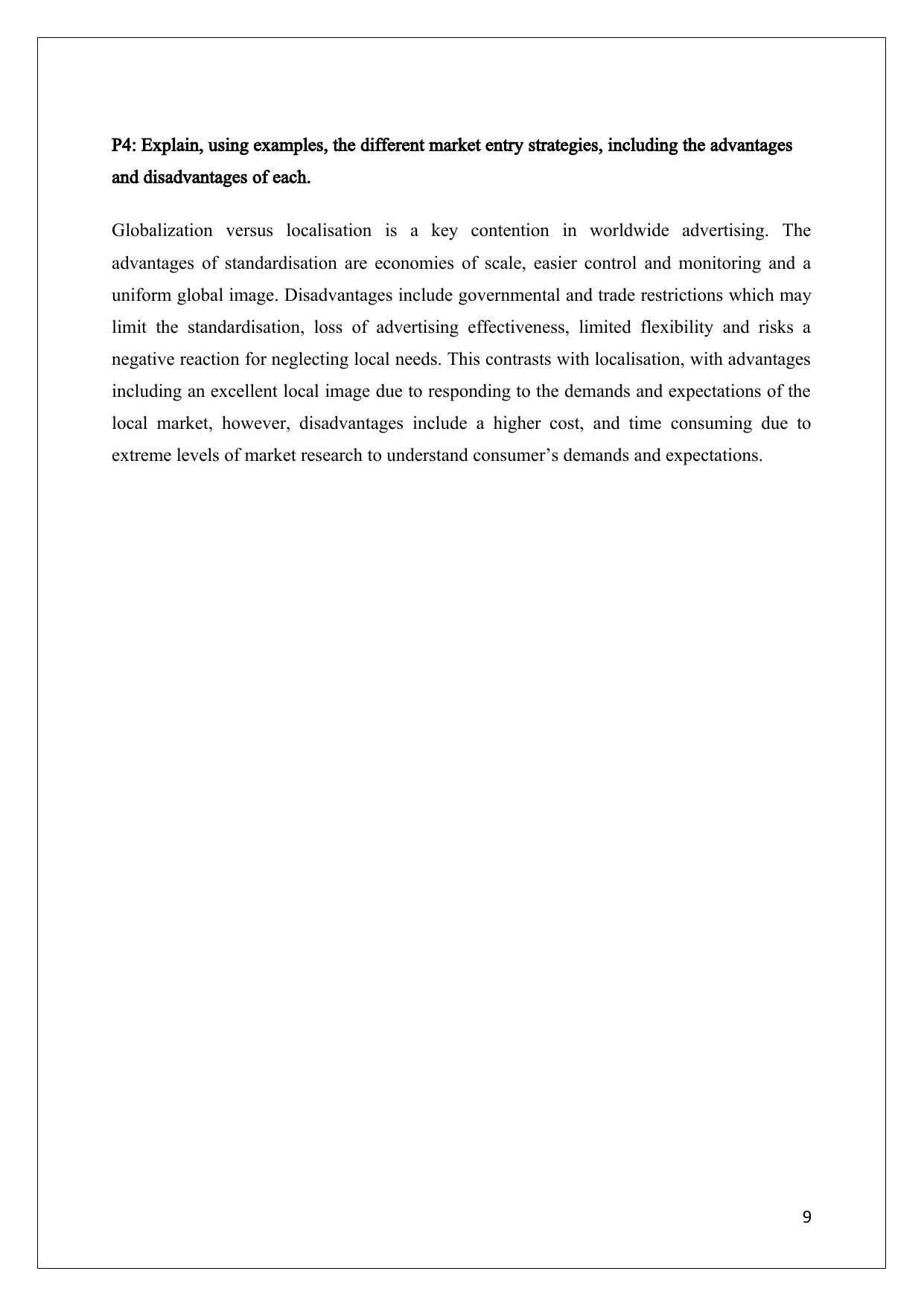
P4: Explain, using examples, the different market entry strategies, including the advantages
and disadvantages of each.
Globalization versus localisation is a key contention in worldwide advertising. The
advantages of standardisation are economies of scale, easier control and monitoring and a
uniform global image. Disadvantages include governmental and trade restrictions which may
limit the standardisation, loss of advertising effectiveness, limited flexibility and risks a
negative reaction for neglecting local needs. This contrasts with localisation, with advantages
including an excellent local image due to responding to the demands and expectations of the
local market, however, disadvantages include a higher cost, and time consuming due to
extreme levels of market research to understand consumer’s demands and expectations.
9
and disadvantages of each.
Globalization versus localisation is a key contention in worldwide advertising. The
advantages of standardisation are economies of scale, easier control and monitoring and a
uniform global image. Disadvantages include governmental and trade restrictions which may
limit the standardisation, loss of advertising effectiveness, limited flexibility and risks a
negative reaction for neglecting local needs. This contrasts with localisation, with advantages
including an excellent local image due to responding to the demands and expectations of the
local market, however, disadvantages include a higher cost, and time consuming due to
extreme levels of market research to understand consumer’s demands and expectations.
9

D1: Organisational Adaption
Organisations must adapt their marketing strategies for various markets. If a business was
standardised internationally, it can create a negative reaction due to neglecting the local
needs. For example, McDonalds, a fast-food chain, did not adapt to the culture within India
after the initial store opening. McDonalds tend to sell beef in their products such as the Big
Mac, and without the market research to learn that people in India do not eat beef due to
finding the cow sacred, they weren’t making a profit and many local people were unsatisfied.
Although adapting can be costly, it respects local specification and expectations.
Organisations must adapt culturally and economically, finding the information by embarking
on market research (Griffith, 2012). By adapting to the needs and wants to increase the
chances of remaining competitive and marketing orientated within the international market.
10
Organisations must adapt their marketing strategies for various markets. If a business was
standardised internationally, it can create a negative reaction due to neglecting the local
needs. For example, McDonalds, a fast-food chain, did not adapt to the culture within India
after the initial store opening. McDonalds tend to sell beef in their products such as the Big
Mac, and without the market research to learn that people in India do not eat beef due to
finding the cow sacred, they weren’t making a profit and many local people were unsatisfied.
Although adapting can be costly, it respects local specification and expectations.
Organisations must adapt culturally and economically, finding the information by embarking
on market research (Griffith, 2012). By adapting to the needs and wants to increase the
chances of remaining competitive and marketing orientated within the international market.
10
Secure Best Marks with AI Grader
Need help grading? Try our AI Grader for instant feedback on your assignments.

LO3
P5: Overview of the key arguments in the global versus local debate
When an organisation considers an international market, they must determine competitive
advantage of a country before entering the global market. Porter introduced the Diamond of
National Advantage theory which includes four factors that determine the competitive
advantage of a country which should be used during the selection process when considering
which market to enter. The four factors include:
Factor Conditions – The country’s position in factors of production which are
necessary to compete. For example, Coca Cola’s first European cogeneration facility
was based in Bucharest, Romania, which has kept costs low due to the country having
a minimum wage of 232.10 Euros per month for full time workers.
Demand Conditions – The country’s demand for the organisation’s product/service.
For example, in 2009, products with artificial food colourings were being banned in
Norway, leading to many organisations such as Kraft to either adapt or remove them
from that specific market.
Related and supporting industries – The level of presence of suppliers and similar
industries that is internationally competitive. For example, in Apple’s position China
has a high availability of suppliers who can produce the products at the cheapest cost
and is the leading B2B portal.
Organisation’s strategy, structure and rivalry – The conditions that an organisation is
controlled in terms of creating, organising and managing and the level of domestic
competition. For example, German organisations tend to be hierarchal; Italian’s tend
to be smaller with many families running the organisation.
Porter argues that an organisation’s competitive edge depends on the strengths of each of
these detrimental factors. They also affect production such as by encouraging the use of
renewable energy which is an objective in the UK with the reduction of carbon under the
Climate Change Act (2008), which doesn’t stand in other countries. Porter also argued that
developments outside the organisations control such as war, recessions, and revolutions
known as chance plays an important role in exploiting opportunities.
11
P5: Overview of the key arguments in the global versus local debate
When an organisation considers an international market, they must determine competitive
advantage of a country before entering the global market. Porter introduced the Diamond of
National Advantage theory which includes four factors that determine the competitive
advantage of a country which should be used during the selection process when considering
which market to enter. The four factors include:
Factor Conditions – The country’s position in factors of production which are
necessary to compete. For example, Coca Cola’s first European cogeneration facility
was based in Bucharest, Romania, which has kept costs low due to the country having
a minimum wage of 232.10 Euros per month for full time workers.
Demand Conditions – The country’s demand for the organisation’s product/service.
For example, in 2009, products with artificial food colourings were being banned in
Norway, leading to many organisations such as Kraft to either adapt or remove them
from that specific market.
Related and supporting industries – The level of presence of suppliers and similar
industries that is internationally competitive. For example, in Apple’s position China
has a high availability of suppliers who can produce the products at the cheapest cost
and is the leading B2B portal.
Organisation’s strategy, structure and rivalry – The conditions that an organisation is
controlled in terms of creating, organising and managing and the level of domestic
competition. For example, German organisations tend to be hierarchal; Italian’s tend
to be smaller with many families running the organisation.
Porter argues that an organisation’s competitive edge depends on the strengths of each of
these detrimental factors. They also affect production such as by encouraging the use of
renewable energy which is an objective in the UK with the reduction of carbon under the
Climate Change Act (2008), which doesn’t stand in other countries. Porter also argued that
developments outside the organisations control such as war, recessions, and revolutions
known as chance plays an important role in exploiting opportunities.
11
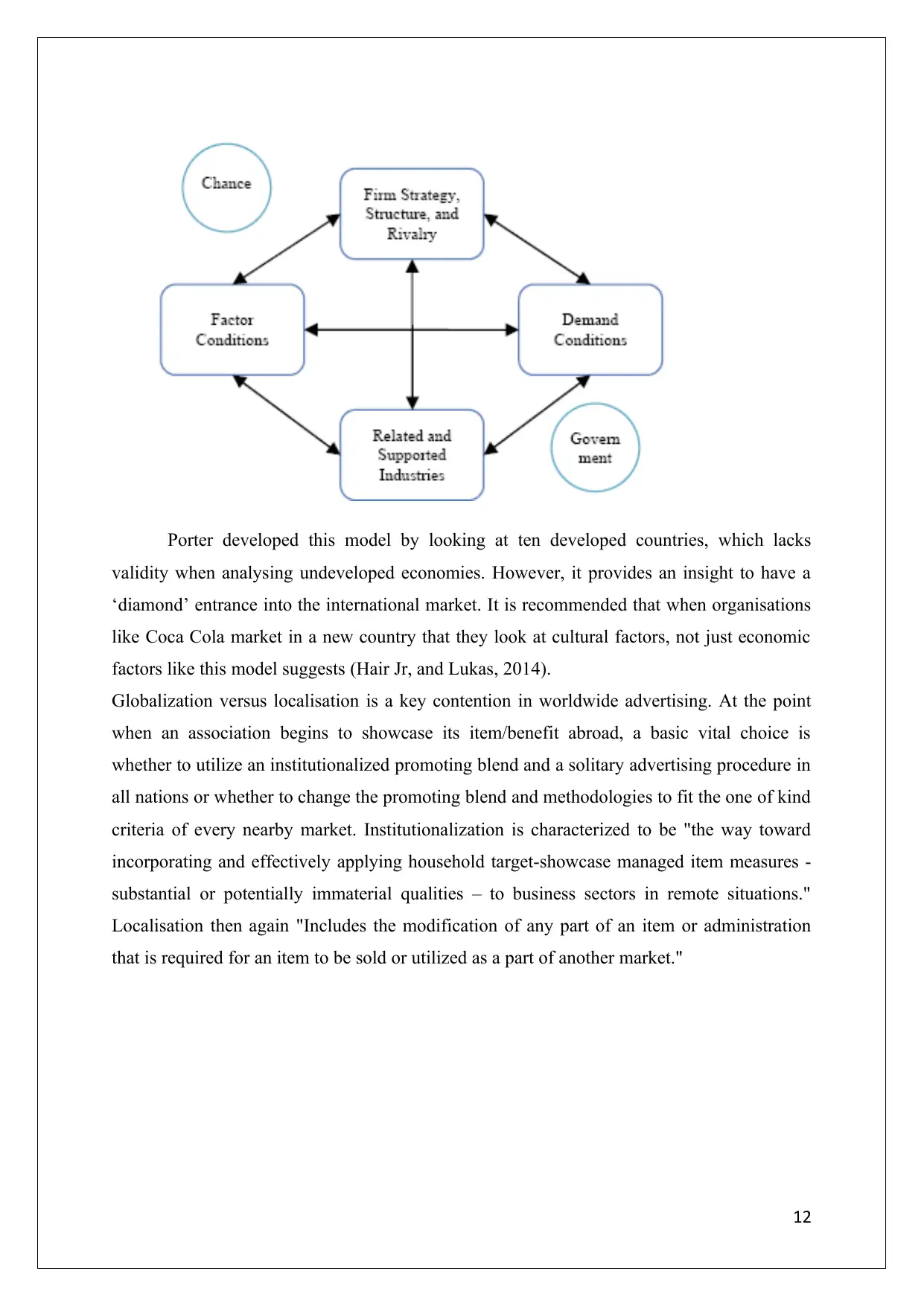
Porter developed this model by looking at ten developed countries, which lacks
validity when analysing undeveloped economies. However, it provides an insight to have a
‘diamond’ entrance into the international market. It is recommended that when organisations
like Coca Cola market in a new country that they look at cultural factors, not just economic
factors like this model suggests (Hair Jr, and Lukas, 2014).
Globalization versus localisation is a key contention in worldwide advertising. At the point
when an association begins to showcase its item/benefit abroad, a basic vital choice is
whether to utilize an institutionalized promoting blend and a solitary advertising procedure in
all nations or whether to change the promoting blend and methodologies to fit the one of kind
criteria of every nearby market. Institutionalization is characterized to be "the way toward
incorporating and effectively applying household target-showcase managed item measures -
substantial or potentially immaterial qualities – to business sectors in remote situations."
Localisation then again "Includes the modification of any part of an item or administration
that is required for an item to be sold or utilized as a part of another market."
12
validity when analysing undeveloped economies. However, it provides an insight to have a
‘diamond’ entrance into the international market. It is recommended that when organisations
like Coca Cola market in a new country that they look at cultural factors, not just economic
factors like this model suggests (Hair Jr, and Lukas, 2014).
Globalization versus localisation is a key contention in worldwide advertising. At the point
when an association begins to showcase its item/benefit abroad, a basic vital choice is
whether to utilize an institutionalized promoting blend and a solitary advertising procedure in
all nations or whether to change the promoting blend and methodologies to fit the one of kind
criteria of every nearby market. Institutionalization is characterized to be "the way toward
incorporating and effectively applying household target-showcase managed item measures -
substantial or potentially immaterial qualities – to business sectors in remote situations."
Localisation then again "Includes the modification of any part of an item or administration
that is required for an item to be sold or utilized as a part of another market."
12
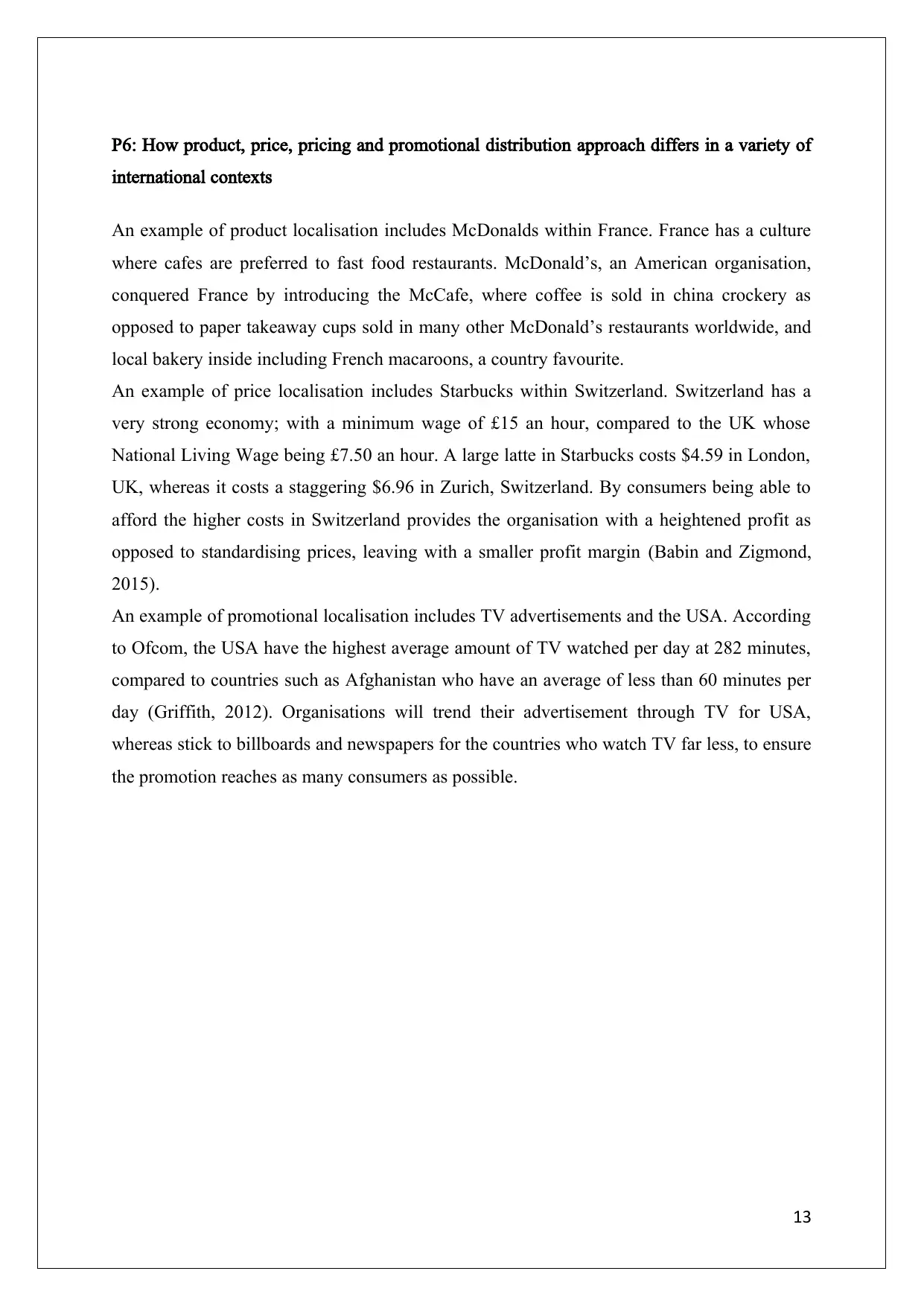
P6: How product, price, pricing and promotional distribution approach differs in a variety of
international contexts
An example of product localisation includes McDonalds within France. France has a culture
where cafes are preferred to fast food restaurants. McDonald’s, an American organisation,
conquered France by introducing the McCafe, where coffee is sold in china crockery as
opposed to paper takeaway cups sold in many other McDonald’s restaurants worldwide, and
local bakery inside including French macaroons, a country favourite.
An example of price localisation includes Starbucks within Switzerland. Switzerland has a
very strong economy; with a minimum wage of £15 an hour, compared to the UK whose
National Living Wage being £7.50 an hour. A large latte in Starbucks costs $4.59 in London,
UK, whereas it costs a staggering $6.96 in Zurich, Switzerland. By consumers being able to
afford the higher costs in Switzerland provides the organisation with a heightened profit as
opposed to standardising prices, leaving with a smaller profit margin (Babin and Zigmond,
2015).
An example of promotional localisation includes TV advertisements and the USA. According
to Ofcom, the USA have the highest average amount of TV watched per day at 282 minutes,
compared to countries such as Afghanistan who have an average of less than 60 minutes per
day (Griffith, 2012). Organisations will trend their advertisement through TV for USA,
whereas stick to billboards and newspapers for the countries who watch TV far less, to ensure
the promotion reaches as many consumers as possible.
13
international contexts
An example of product localisation includes McDonalds within France. France has a culture
where cafes are preferred to fast food restaurants. McDonald’s, an American organisation,
conquered France by introducing the McCafe, where coffee is sold in china crockery as
opposed to paper takeaway cups sold in many other McDonald’s restaurants worldwide, and
local bakery inside including French macaroons, a country favourite.
An example of price localisation includes Starbucks within Switzerland. Switzerland has a
very strong economy; with a minimum wage of £15 an hour, compared to the UK whose
National Living Wage being £7.50 an hour. A large latte in Starbucks costs $4.59 in London,
UK, whereas it costs a staggering $6.96 in Zurich, Switzerland. By consumers being able to
afford the higher costs in Switzerland provides the organisation with a heightened profit as
opposed to standardising prices, leaving with a smaller profit margin (Babin and Zigmond,
2015).
An example of promotional localisation includes TV advertisements and the USA. According
to Ofcom, the USA have the highest average amount of TV watched per day at 282 minutes,
compared to countries such as Afghanistan who have an average of less than 60 minutes per
day (Griffith, 2012). Organisations will trend their advertisement through TV for USA,
whereas stick to billboards and newspapers for the countries who watch TV far less, to ensure
the promotion reaches as many consumers as possible.
13
Paraphrase This Document
Need a fresh take? Get an instant paraphrase of this document with our AI Paraphraser
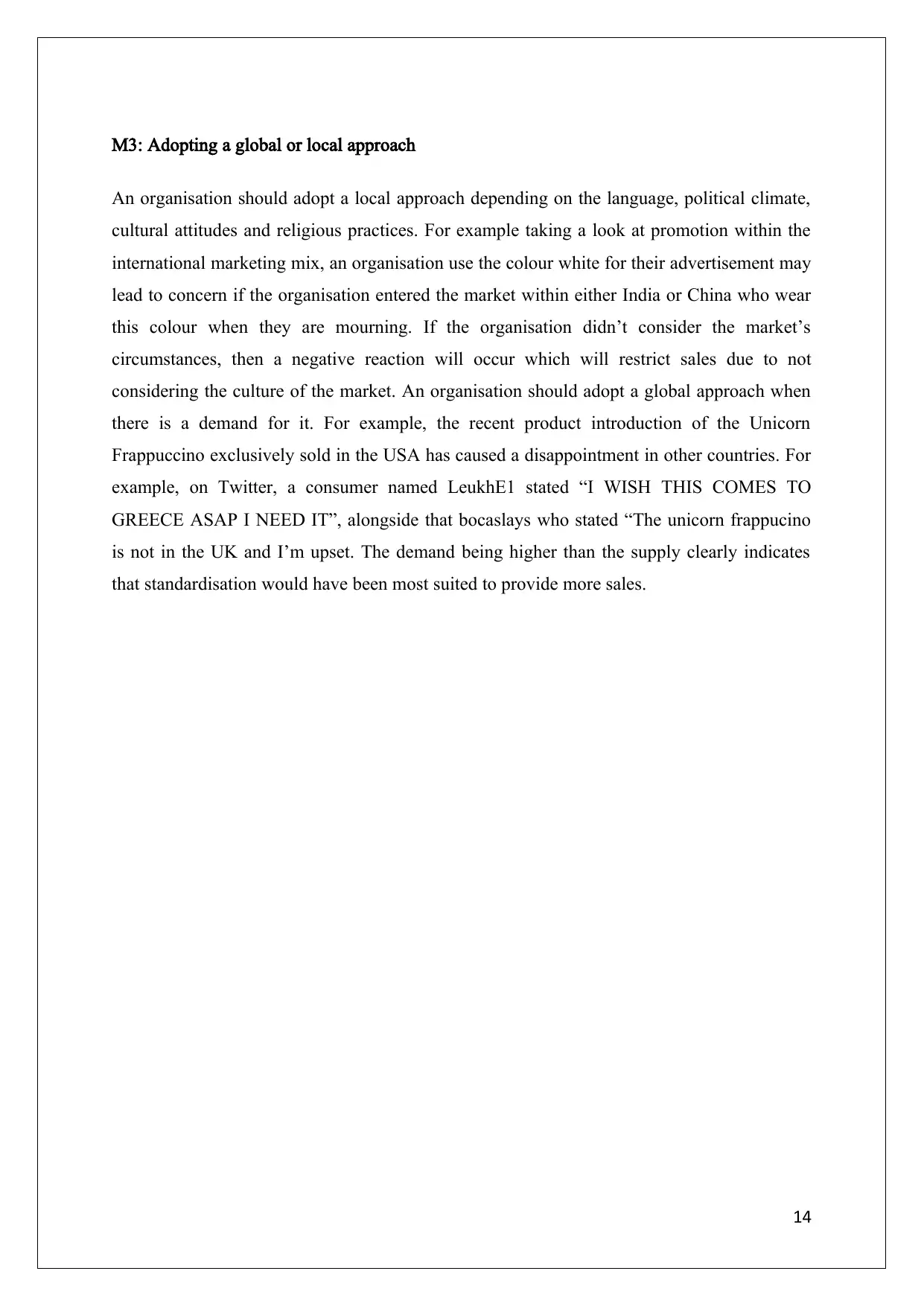
M3: Adopting a global or local approach
An organisation should adopt a local approach depending on the language, political climate,
cultural attitudes and religious practices. For example taking a look at promotion within the
international marketing mix, an organisation use the colour white for their advertisement may
lead to concern if the organisation entered the market within either India or China who wear
this colour when they are mourning. If the organisation didn’t consider the market’s
circumstances, then a negative reaction will occur which will restrict sales due to not
considering the culture of the market. An organisation should adopt a global approach when
there is a demand for it. For example, the recent product introduction of the Unicorn
Frappuccino exclusively sold in the USA has caused a disappointment in other countries. For
example, on Twitter, a consumer named LeukhE1 stated “I WISH THIS COMES TO
GREECE ASAP I NEED IT”, alongside that bocaslays who stated “The unicorn frappucino
is not in the UK and I’m upset. The demand being higher than the supply clearly indicates
that standardisation would have been most suited to provide more sales.
14
An organisation should adopt a local approach depending on the language, political climate,
cultural attitudes and religious practices. For example taking a look at promotion within the
international marketing mix, an organisation use the colour white for their advertisement may
lead to concern if the organisation entered the market within either India or China who wear
this colour when they are mourning. If the organisation didn’t consider the market’s
circumstances, then a negative reaction will occur which will restrict sales due to not
considering the culture of the market. An organisation should adopt a global approach when
there is a demand for it. For example, the recent product introduction of the Unicorn
Frappuccino exclusively sold in the USA has caused a disappointment in other countries. For
example, on Twitter, a consumer named LeukhE1 stated “I WISH THIS COMES TO
GREECE ASAP I NEED IT”, alongside that bocaslays who stated “The unicorn frappucino
is not in the UK and I’m upset. The demand being higher than the supply clearly indicates
that standardisation would have been most suited to provide more sales.
14

M4: Marketing mix
The marketing mix is adapted within Coca Cola. Promotions have been adapted within
different international markets. For example in January 2016, 10 different commercials were
released to specific markets. This promotion makes the local market feel noticed and will be
more inclined to purchase from Coca Cola, and is more important than the cost implications.
Coca Cola have adapted their product within international markets. For example, in
Shenzhen, China, who is more health conscious compared to other countries, Coca Cola
produce carbonated fruit-based drinks and bottled water instead of the typical product which
is high in sugar with no additional health benefits. This helps the country to contribute
towards a healthier culture which will allow the local consumer to respect Coca Cola,
however, it would have been time consuming to adapt to their needs by increasing their range
of products, which would be costly short-term, but will be efficient long-term (Babinand
Zigmond, 2015).
15
The marketing mix is adapted within Coca Cola. Promotions have been adapted within
different international markets. For example in January 2016, 10 different commercials were
released to specific markets. This promotion makes the local market feel noticed and will be
more inclined to purchase from Coca Cola, and is more important than the cost implications.
Coca Cola have adapted their product within international markets. For example, in
Shenzhen, China, who is more health conscious compared to other countries, Coca Cola
produce carbonated fruit-based drinks and bottled water instead of the typical product which
is high in sugar with no additional health benefits. This helps the country to contribute
towards a healthier culture which will allow the local consumer to respect Coca Cola,
however, it would have been time consuming to adapt to their needs by increasing their range
of products, which would be costly short-term, but will be efficient long-term (Babinand
Zigmond, 2015).
15
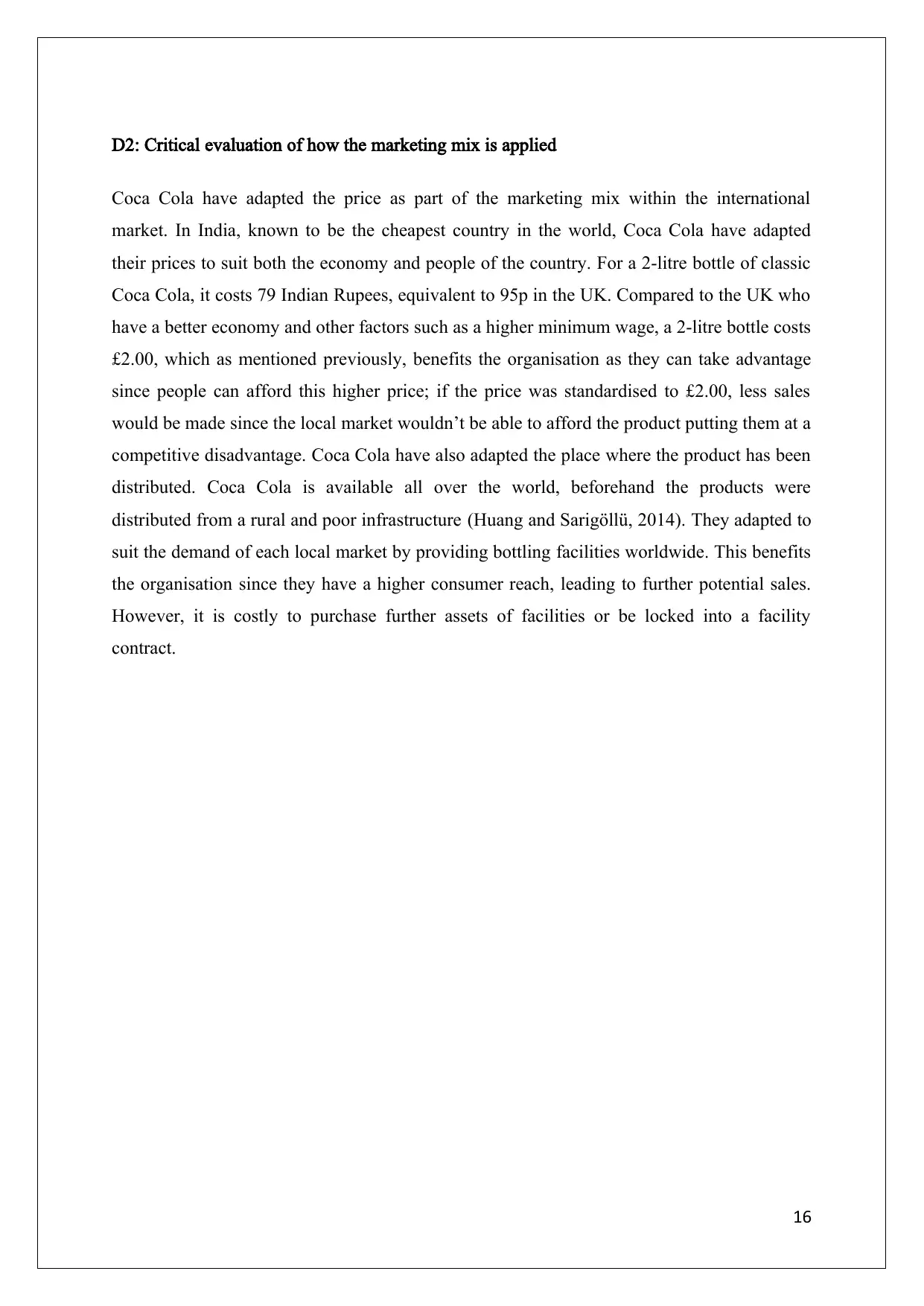
D2: Critical evaluation of how the marketing mix is applied
Coca Cola have adapted the price as part of the marketing mix within the international
market. In India, known to be the cheapest country in the world, Coca Cola have adapted
their prices to suit both the economy and people of the country. For a 2-litre bottle of classic
Coca Cola, it costs 79 Indian Rupees, equivalent to 95p in the UK. Compared to the UK who
have a better economy and other factors such as a higher minimum wage, a 2-litre bottle costs
£2.00, which as mentioned previously, benefits the organisation as they can take advantage
since people can afford this higher price; if the price was standardised to £2.00, less sales
would be made since the local market wouldn’t be able to afford the product putting them at a
competitive disadvantage. Coca Cola have also adapted the place where the product has been
distributed. Coca Cola is available all over the world, beforehand the products were
distributed from a rural and poor infrastructure (Huang and Sarigöllü, 2014). They adapted to
suit the demand of each local market by providing bottling facilities worldwide. This benefits
the organisation since they have a higher consumer reach, leading to further potential sales.
However, it is costly to purchase further assets of facilities or be locked into a facility
contract.
16
Coca Cola have adapted the price as part of the marketing mix within the international
market. In India, known to be the cheapest country in the world, Coca Cola have adapted
their prices to suit both the economy and people of the country. For a 2-litre bottle of classic
Coca Cola, it costs 79 Indian Rupees, equivalent to 95p in the UK. Compared to the UK who
have a better economy and other factors such as a higher minimum wage, a 2-litre bottle costs
£2.00, which as mentioned previously, benefits the organisation as they can take advantage
since people can afford this higher price; if the price was standardised to £2.00, less sales
would be made since the local market wouldn’t be able to afford the product putting them at a
competitive disadvantage. Coca Cola have also adapted the place where the product has been
distributed. Coca Cola is available all over the world, beforehand the products were
distributed from a rural and poor infrastructure (Huang and Sarigöllü, 2014). They adapted to
suit the demand of each local market by providing bottling facilities worldwide. This benefits
the organisation since they have a higher consumer reach, leading to further potential sales.
However, it is costly to purchase further assets of facilities or be locked into a facility
contract.
16
Secure Best Marks with AI Grader
Need help grading? Try our AI Grader for instant feedback on your assignments.
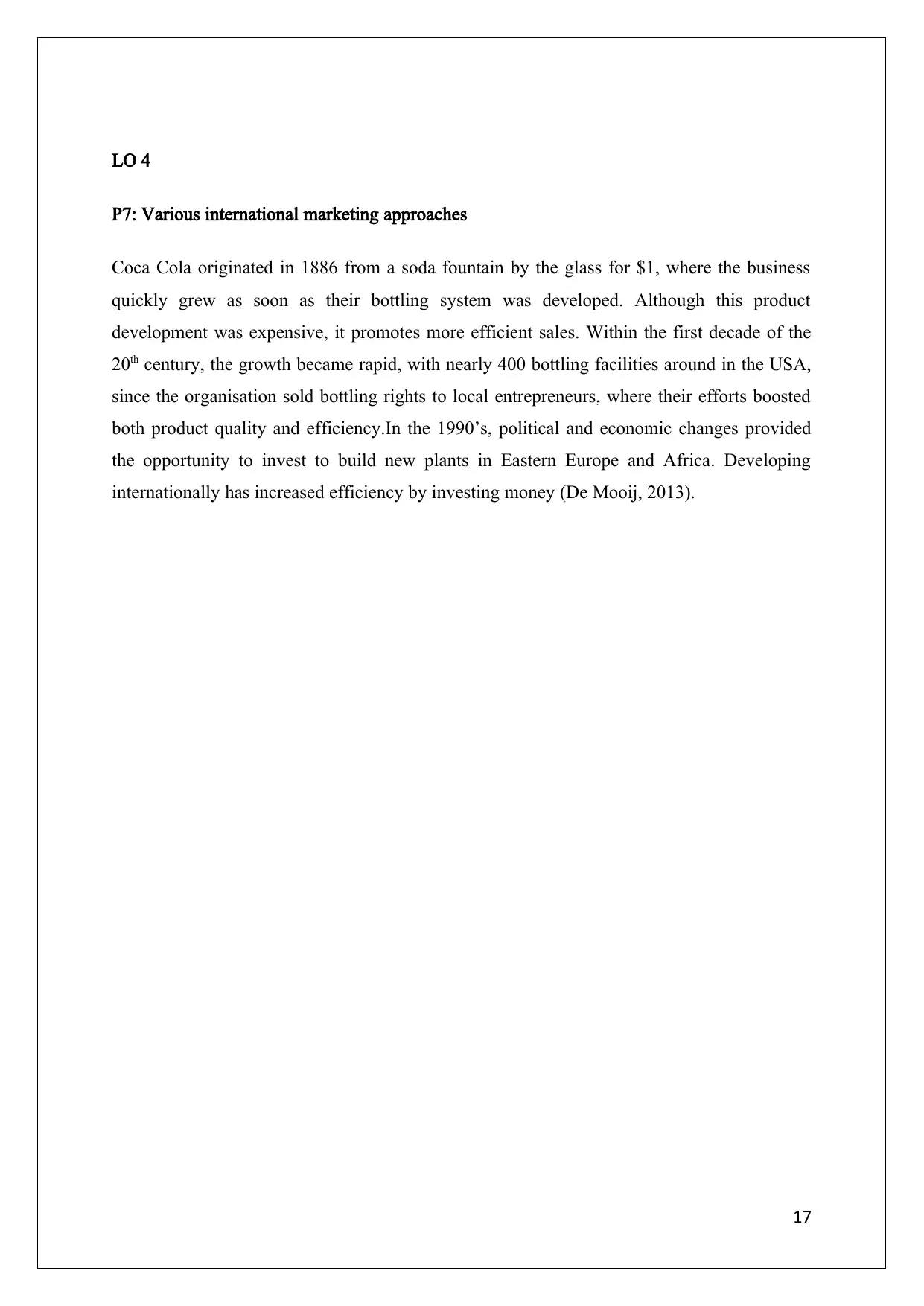
LO 4
P7: Various international marketing approaches
Coca Cola originated in 1886 from a soda fountain by the glass for $1, where the business
quickly grew as soon as their bottling system was developed. Although this product
development was expensive, it promotes more efficient sales. Within the first decade of the
20th century, the growth became rapid, with nearly 400 bottling facilities around in the USA,
since the organisation sold bottling rights to local entrepreneurs, where their efforts boosted
both product quality and efficiency.In the 1990’s, political and economic changes provided
the opportunity to invest to build new plants in Eastern Europe and Africa. Developing
internationally has increased efficiency by investing money (De Mooij, 2013).
17
P7: Various international marketing approaches
Coca Cola originated in 1886 from a soda fountain by the glass for $1, where the business
quickly grew as soon as their bottling system was developed. Although this product
development was expensive, it promotes more efficient sales. Within the first decade of the
20th century, the growth became rapid, with nearly 400 bottling facilities around in the USA,
since the organisation sold bottling rights to local entrepreneurs, where their efforts boosted
both product quality and efficiency.In the 1990’s, political and economic changes provided
the opportunity to invest to build new plants in Eastern Europe and Africa. Developing
internationally has increased efficiency by investing money (De Mooij, 2013).
17
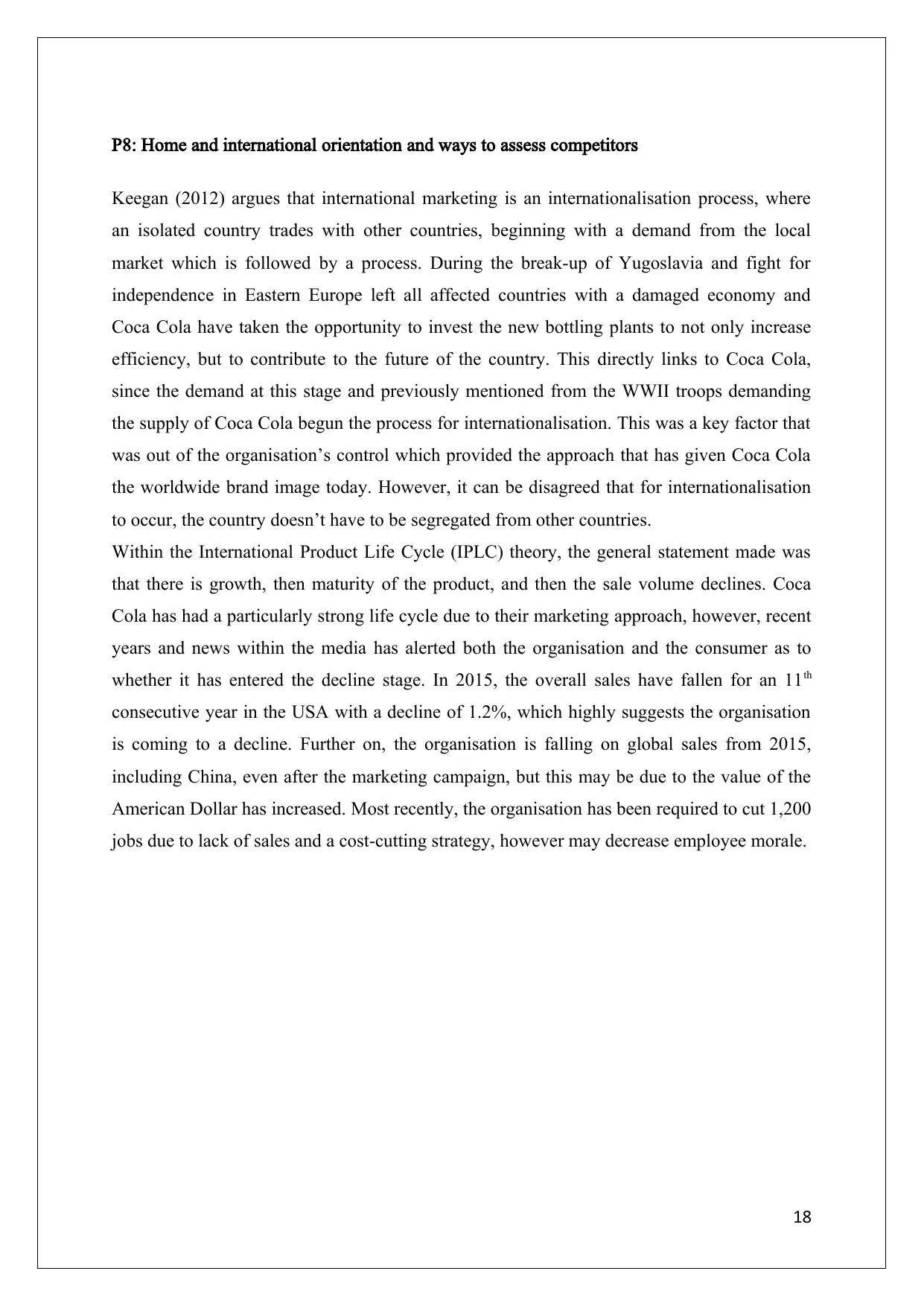
P8: Home and international orientation and ways to assess competitors
Keegan (2012) argues that international marketing is an internationalisation process, where
an isolated country trades with other countries, beginning with a demand from the local
market which is followed by a process. During the break-up of Yugoslavia and fight for
independence in Eastern Europe left all affected countries with a damaged economy and
Coca Cola have taken the opportunity to invest the new bottling plants to not only increase
efficiency, but to contribute to the future of the country. This directly links to Coca Cola,
since the demand at this stage and previously mentioned from the WWII troops demanding
the supply of Coca Cola begun the process for internationalisation. This was a key factor that
was out of the organisation’s control which provided the approach that has given Coca Cola
the worldwide brand image today. However, it can be disagreed that for internationalisation
to occur, the country doesn’t have to be segregated from other countries.
Within the International Product Life Cycle (IPLC) theory, the general statement made was
that there is growth, then maturity of the product, and then the sale volume declines. Coca
Cola has had a particularly strong life cycle due to their marketing approach, however, recent
years and news within the media has alerted both the organisation and the consumer as to
whether it has entered the decline stage. In 2015, the overall sales have fallen for an 11th
consecutive year in the USA with a decline of 1.2%, which highly suggests the organisation
is coming to a decline. Further on, the organisation is falling on global sales from 2015,
including China, even after the marketing campaign, but this may be due to the value of the
American Dollar has increased. Most recently, the organisation has been required to cut 1,200
jobs due to lack of sales and a cost-cutting strategy, however may decrease employee morale.
18
Keegan (2012) argues that international marketing is an internationalisation process, where
an isolated country trades with other countries, beginning with a demand from the local
market which is followed by a process. During the break-up of Yugoslavia and fight for
independence in Eastern Europe left all affected countries with a damaged economy and
Coca Cola have taken the opportunity to invest the new bottling plants to not only increase
efficiency, but to contribute to the future of the country. This directly links to Coca Cola,
since the demand at this stage and previously mentioned from the WWII troops demanding
the supply of Coca Cola begun the process for internationalisation. This was a key factor that
was out of the organisation’s control which provided the approach that has given Coca Cola
the worldwide brand image today. However, it can be disagreed that for internationalisation
to occur, the country doesn’t have to be segregated from other countries.
Within the International Product Life Cycle (IPLC) theory, the general statement made was
that there is growth, then maturity of the product, and then the sale volume declines. Coca
Cola has had a particularly strong life cycle due to their marketing approach, however, recent
years and news within the media has alerted both the organisation and the consumer as to
whether it has entered the decline stage. In 2015, the overall sales have fallen for an 11th
consecutive year in the USA with a decline of 1.2%, which highly suggests the organisation
is coming to a decline. Further on, the organisation is falling on global sales from 2015,
including China, even after the marketing campaign, but this may be due to the value of the
American Dollar has increased. Most recently, the organisation has been required to cut 1,200
jobs due to lack of sales and a cost-cutting strategy, however may decrease employee morale.
18
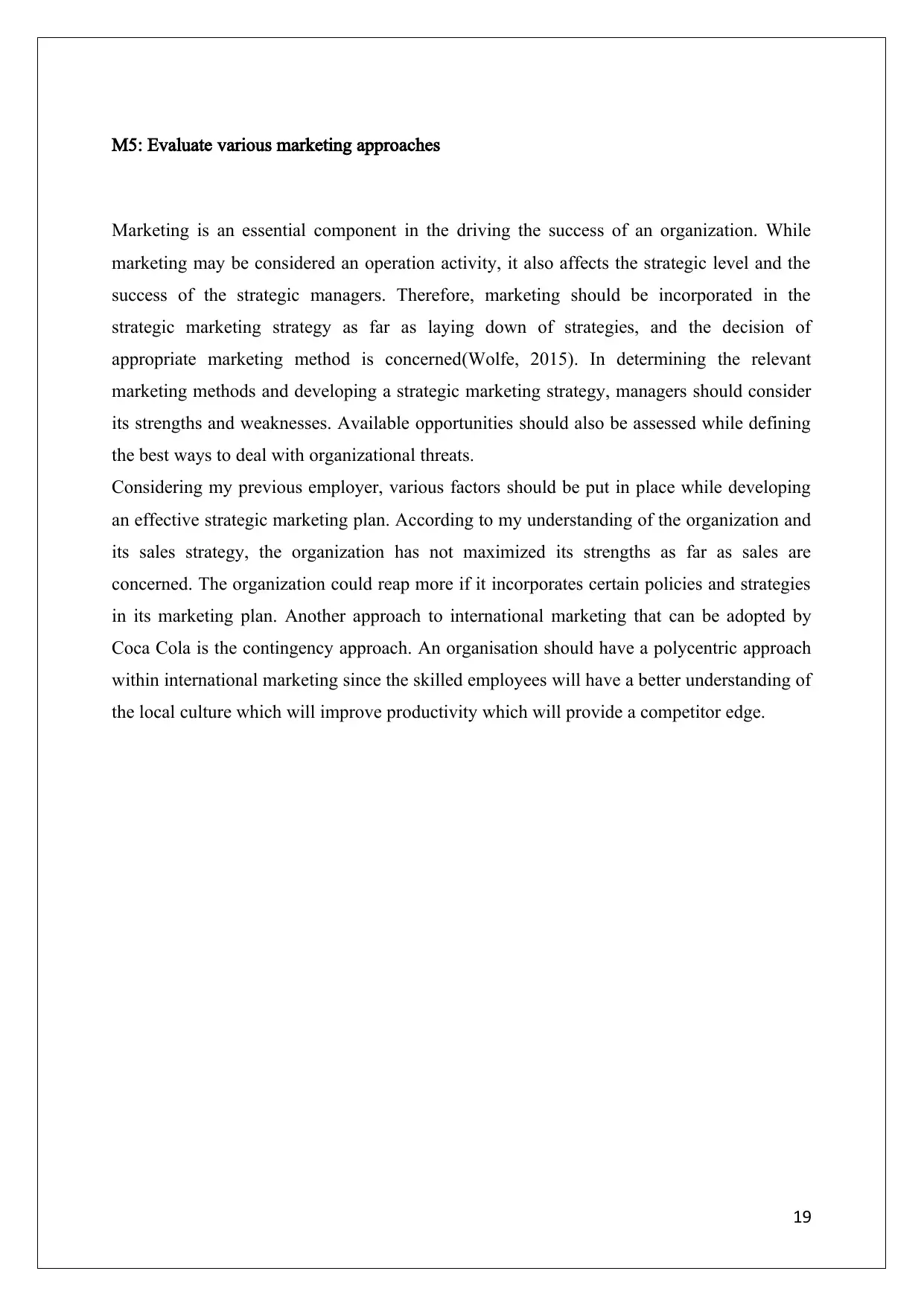
M5: Evaluate various marketing approaches
Marketing is an essential component in the driving the success of an organization. While
marketing may be considered an operation activity, it also affects the strategic level and the
success of the strategic managers. Therefore, marketing should be incorporated in the
strategic marketing strategy as far as laying down of strategies, and the decision of
appropriate marketing method is concerned(Wolfe, 2015). In determining the relevant
marketing methods and developing a strategic marketing strategy, managers should consider
its strengths and weaknesses. Available opportunities should also be assessed while defining
the best ways to deal with organizational threats.
Considering my previous employer, various factors should be put in place while developing
an effective strategic marketing plan. According to my understanding of the organization and
its sales strategy, the organization has not maximized its strengths as far as sales are
concerned. The organization could reap more if it incorporates certain policies and strategies
in its marketing plan. Another approach to international marketing that can be adopted by
Coca Cola is the contingency approach. An organisation should have a polycentric approach
within international marketing since the skilled employees will have a better understanding of
the local culture which will improve productivity which will provide a competitor edge.
19
Marketing is an essential component in the driving the success of an organization. While
marketing may be considered an operation activity, it also affects the strategic level and the
success of the strategic managers. Therefore, marketing should be incorporated in the
strategic marketing strategy as far as laying down of strategies, and the decision of
appropriate marketing method is concerned(Wolfe, 2015). In determining the relevant
marketing methods and developing a strategic marketing strategy, managers should consider
its strengths and weaknesses. Available opportunities should also be assessed while defining
the best ways to deal with organizational threats.
Considering my previous employer, various factors should be put in place while developing
an effective strategic marketing plan. According to my understanding of the organization and
its sales strategy, the organization has not maximized its strengths as far as sales are
concerned. The organization could reap more if it incorporates certain policies and strategies
in its marketing plan. Another approach to international marketing that can be adopted by
Coca Cola is the contingency approach. An organisation should have a polycentric approach
within international marketing since the skilled employees will have a better understanding of
the local culture which will improve productivity which will provide a competitor edge.
19
Paraphrase This Document
Need a fresh take? Get an instant paraphrase of this document with our AI Paraphraser
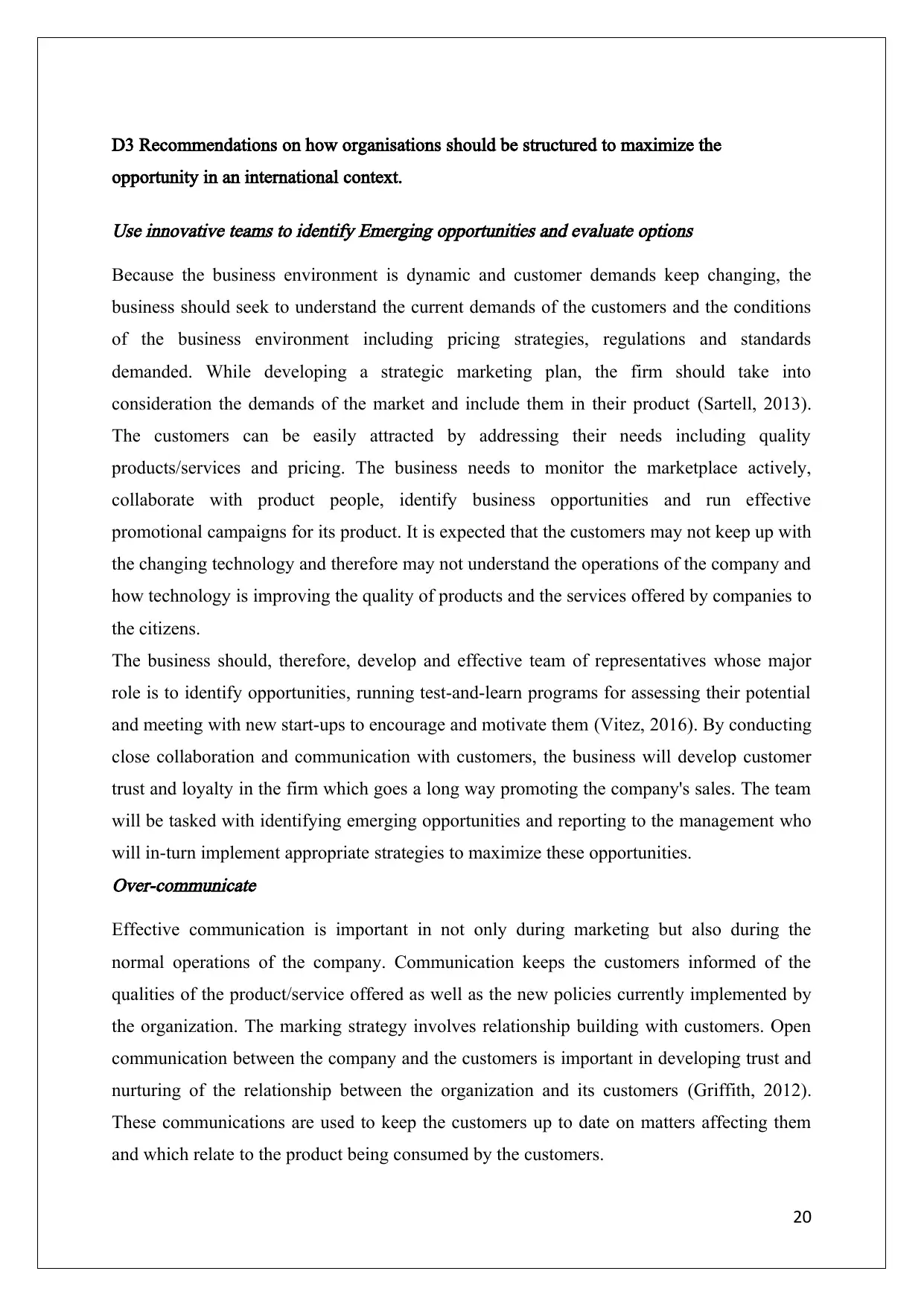
D3 Recommendations on how organisations should be structured to maximize the
opportunity in an international context.
Use innovative teams to identify Emerging opportunities and evaluate options
Because the business environment is dynamic and customer demands keep changing, the
business should seek to understand the current demands of the customers and the conditions
of the business environment including pricing strategies, regulations and standards
demanded. While developing a strategic marketing plan, the firm should take into
consideration the demands of the market and include them in their product (Sartell, 2013).
The customers can be easily attracted by addressing their needs including quality
products/services and pricing. The business needs to monitor the marketplace actively,
collaborate with product people, identify business opportunities and run effective
promotional campaigns for its product. It is expected that the customers may not keep up with
the changing technology and therefore may not understand the operations of the company and
how technology is improving the quality of products and the services offered by companies to
the citizens.
The business should, therefore, develop and effective team of representatives whose major
role is to identify opportunities, running test-and-learn programs for assessing their potential
and meeting with new start-ups to encourage and motivate them (Vitez, 2016). By conducting
close collaboration and communication with customers, the business will develop customer
trust and loyalty in the firm which goes a long way promoting the company's sales. The team
will be tasked with identifying emerging opportunities and reporting to the management who
will in-turn implement appropriate strategies to maximize these opportunities.Over-communicate
Effective communication is important in not only during marketing but also during the
normal operations of the company. Communication keeps the customers informed of the
qualities of the product/service offered as well as the new policies currently implemented by
the organization. The marking strategy involves relationship building with customers. Open
communication between the company and the customers is important in developing trust and
nurturing of the relationship between the organization and its customers (Griffith, 2012).
These communications are used to keep the customers up to date on matters affecting them
and which relate to the product being consumed by the customers.
20
opportunity in an international context.
Use innovative teams to identify Emerging opportunities and evaluate options
Because the business environment is dynamic and customer demands keep changing, the
business should seek to understand the current demands of the customers and the conditions
of the business environment including pricing strategies, regulations and standards
demanded. While developing a strategic marketing plan, the firm should take into
consideration the demands of the market and include them in their product (Sartell, 2013).
The customers can be easily attracted by addressing their needs including quality
products/services and pricing. The business needs to monitor the marketplace actively,
collaborate with product people, identify business opportunities and run effective
promotional campaigns for its product. It is expected that the customers may not keep up with
the changing technology and therefore may not understand the operations of the company and
how technology is improving the quality of products and the services offered by companies to
the citizens.
The business should, therefore, develop and effective team of representatives whose major
role is to identify opportunities, running test-and-learn programs for assessing their potential
and meeting with new start-ups to encourage and motivate them (Vitez, 2016). By conducting
close collaboration and communication with customers, the business will develop customer
trust and loyalty in the firm which goes a long way promoting the company's sales. The team
will be tasked with identifying emerging opportunities and reporting to the management who
will in-turn implement appropriate strategies to maximize these opportunities.Over-communicate
Effective communication is important in not only during marketing but also during the
normal operations of the company. Communication keeps the customers informed of the
qualities of the product/service offered as well as the new policies currently implemented by
the organization. The marking strategy involves relationship building with customers. Open
communication between the company and the customers is important in developing trust and
nurturing of the relationship between the organization and its customers (Griffith, 2012).
These communications are used to keep the customers up to date on matters affecting them
and which relate to the product being consumed by the customers.
20

Conclusion
The business should, therefore, develop and effective team of representatives whose major
role is to identify opportunities, running test-and-learn programs for assessing their potential
and meeting with new start-ups to encourage and motivate. Business marketing may take
various forms. However, all marketing channels involve communication between the
organization and the public. The primary goal of marketing, however, is to provide
information to potential consumers and to convince them to purchase or consume a particular
product. Constant communication enhances good relations between the company and
customers; this is important in developing a strategic marketing plan.
21
The business should, therefore, develop and effective team of representatives whose major
role is to identify opportunities, running test-and-learn programs for assessing their potential
and meeting with new start-ups to encourage and motivate. Business marketing may take
various forms. However, all marketing channels involve communication between the
organization and the public. The primary goal of marketing, however, is to provide
information to potential consumers and to convince them to purchase or consume a particular
product. Constant communication enhances good relations between the company and
customers; this is important in developing a strategic marketing plan.
21
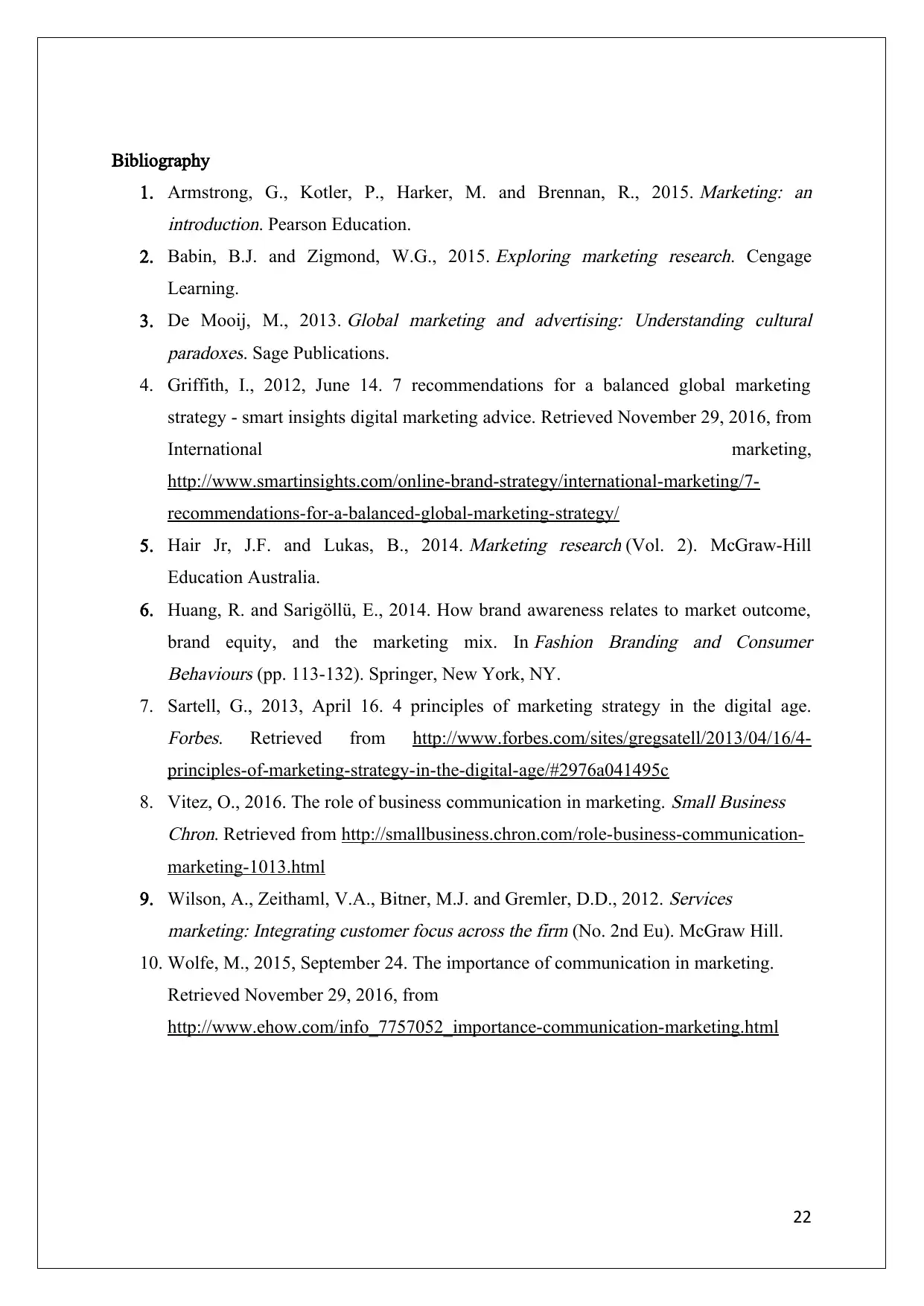
Bibliography
1. Armstrong, G., Kotler, P., Harker, M. and Brennan, R., 2015.
Marketing: an
introduction. Pearson Education.
2. Babin, B.J. and Zigmond, W.G., 2015.
Exploring marketing research. Cengage
Learning.
3. De Mooij, M., 2013.
Global marketing and advertising: Understanding cultural
paradoxes. Sage Publications.
4. Griffith, I., 2012, June 14. 7 recommendations for a balanced global marketing
strategy - smart insights digital marketing advice. Retrieved November 29, 2016, from
International marketing,
http://www.smartinsights.com/online-brand-strategy/international-marketing/7-
recommendations-for-a-balanced-global-marketing-strategy/
5. Hair Jr, J.F. and Lukas, B., 2014.
Marketing research (Vol. 2). McGraw-Hill
Education Australia.
6. Huang, R. and Sarigöllü, E., 2014. How brand awareness relates to market outcome,
brand equity, and the marketing mix. In
Fashion Branding and Consumer
Behaviours (pp. 113-132). Springer, New York, NY.
7. Sartell, G., 2013, April 16. 4 principles of marketing strategy in the digital age.
Forbes. Retrieved from http://www.forbes.com/sites/gregsatell/2013/04/16/4-
principles-of-marketing-strategy-in-the-digital-age/#2976a041495c
8. Vitez, O., 2016. The role of business communication in marketing.
Small Business
Chron. Retrieved from http://smallbusiness.chron.com/role-business-communication-
marketing-1013.html
9. Wilson, A., Zeithaml, V.A., Bitner, M.J. and Gremler, D.D., 2012.
Services
marketing: Integrating customer focus across the firm (No. 2nd Eu). McGraw Hill.
10. Wolfe, M., 2015, September 24. The importance of communication in marketing.
Retrieved November 29, 2016, from
http://www.ehow.com/info_7757052_importance-communication-marketing.html
22
1. Armstrong, G., Kotler, P., Harker, M. and Brennan, R., 2015.
Marketing: an
introduction. Pearson Education.
2. Babin, B.J. and Zigmond, W.G., 2015.
Exploring marketing research. Cengage
Learning.
3. De Mooij, M., 2013.
Global marketing and advertising: Understanding cultural
paradoxes. Sage Publications.
4. Griffith, I., 2012, June 14. 7 recommendations for a balanced global marketing
strategy - smart insights digital marketing advice. Retrieved November 29, 2016, from
International marketing,
http://www.smartinsights.com/online-brand-strategy/international-marketing/7-
recommendations-for-a-balanced-global-marketing-strategy/
5. Hair Jr, J.F. and Lukas, B., 2014.
Marketing research (Vol. 2). McGraw-Hill
Education Australia.
6. Huang, R. and Sarigöllü, E., 2014. How brand awareness relates to market outcome,
brand equity, and the marketing mix. In
Fashion Branding and Consumer
Behaviours (pp. 113-132). Springer, New York, NY.
7. Sartell, G., 2013, April 16. 4 principles of marketing strategy in the digital age.
Forbes. Retrieved from http://www.forbes.com/sites/gregsatell/2013/04/16/4-
principles-of-marketing-strategy-in-the-digital-age/#2976a041495c
8. Vitez, O., 2016. The role of business communication in marketing.
Small Business
Chron. Retrieved from http://smallbusiness.chron.com/role-business-communication-
marketing-1013.html
9. Wilson, A., Zeithaml, V.A., Bitner, M.J. and Gremler, D.D., 2012.
Services
marketing: Integrating customer focus across the firm (No. 2nd Eu). McGraw Hill.
10. Wolfe, M., 2015, September 24. The importance of communication in marketing.
Retrieved November 29, 2016, from
http://www.ehow.com/info_7757052_importance-communication-marketing.html
22
1 out of 22
Related Documents
Your All-in-One AI-Powered Toolkit for Academic Success.
+13062052269
info@desklib.com
Available 24*7 on WhatsApp / Email
![[object Object]](/_next/static/media/star-bottom.7253800d.svg)
Unlock your academic potential
© 2024 | Zucol Services PVT LTD | All rights reserved.





